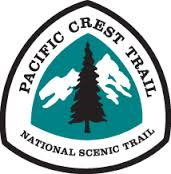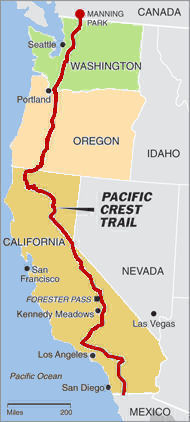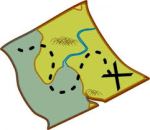My plans are now set for my departure for New Mexico and my shuttle ride to southern terminus of the Continental Divide Trail (CDT). The Southern Terminus “Crazy Cook” is located on the border of New Mexico and Mexico in the Big Hatchet Mountains on Bureau of Land Management federal lands in a fairly remote desert area of New Mexico.  The cool thing is that the Continental Divide Trail Coalition (CDTC) along with volunteers and independent contractors operate a shuttle service for hikers from late March to mid May. They typically schedule no more than ten hikers per day, so your shuttle spot becomes a very important key in setting up your total travel plans. I will be flying into Tucson, AZ from Chattanooga, TN, boarding a Greyhound bus over to Lordsberg, NM and the CDTC shuttle service will pick me up from there. So my tentative hike is pretty well planned at this point. I know many hikers don’t care to plan, but I enjoy semi knowing where and when I plan to be somewhere along the trail. This makes it much easier for family and friends who may want to fly west and schedule a trip to the Rocky Mountains for a visit during the summer which I will appreciate and enjoy greatly!!
The cool thing is that the Continental Divide Trail Coalition (CDTC) along with volunteers and independent contractors operate a shuttle service for hikers from late March to mid May. They typically schedule no more than ten hikers per day, so your shuttle spot becomes a very important key in setting up your total travel plans. I will be flying into Tucson, AZ from Chattanooga, TN, boarding a Greyhound bus over to Lordsberg, NM and the CDTC shuttle service will pick me up from there. So my tentative hike is pretty well planned at this point. I know many hikers don’t care to plan, but I enjoy semi knowing where and when I plan to be somewhere along the trail. This makes it much easier for family and friends who may want to fly west and schedule a trip to the Rocky Mountains for a visit during the summer which I will appreciate and enjoy greatly!!
Being a little bit of a gear junky, it’s been fun going through my gear and making some changes for this year’s CDT hike. One of the biggest changes I’m doing is in my sleeping system. I going with a Katabatic Gear Flex15 sleeping quilt in lieu of a sleeping bag.
Many thru hikers are using quilts these days, mainly to reduce weight and increase comfort. The Flex15 is should be good down to 15 degrees. The Flex does have a zippered foot box and closure guard for those really cold nights, but on the milder nights it can completely open up to a blanket. It’s truly a very flexible sleep system and that’s what I’m hoping for on my hike.
What makes a quilt different from a conventional sleeping bag? A quilt style sleep system eliminates the insulation that is on the bottom of a conventional sleeping bag. With a conventional sleeping bag, any insulation under your body is crushed. Since insulation must have loft and trap air to be effective, the crushed insulation under your body is wasted. So a quilt leaves the insulation out of the bottom of the bag. One other major difference is that no hoods exists on quilts. The Katabatic quilt features an overstuffed down collar around the neck opening. This becomes a critical area to seal the warmth inside your sleeping system or bag. This collar should fit comfortably around the neck, and will keep the warm air where it belongs. So, what happens on those really cold nights when you need your head to be warm as well? You use a separate hood. I purchased a Windom Hood which is basically an ultralight balaclava. The idea here is that your sleeping bag will stay in place on top of your pad and your hood will stay in place on top of your head. I know in my days of using a conventional sleeping bag that I’ve woken up on many nights wet from condensation with my head stuck way down in my sleeping bag and trying to figure out where I am with the bag tangled up around me.
You use a separate hood. I purchased a Windom Hood which is basically an ultralight balaclava. The idea here is that your sleeping bag will stay in place on top of your pad and your hood will stay in place on top of your head. I know in my days of using a conventional sleeping bag that I’ve woken up on many nights wet from condensation with my head stuck way down in my sleeping bag and trying to figure out where I am with the bag tangled up around me.
 Another important device that I’ve purchased and have chosen to bring with me this year is a Garmin inReach Mini. It’s a palm-sized satellite communicator and weighs only 3.5 ounces. Knowing how I can be 100 miles from nowhere, the inReach Mini will allow me to send and receive text messages, track and share my journey, and if necessary, will trigger an SOS alert to contact a GEOS 24/7 emergency response team. By carrying this inReach device, my family and friends will know they can stay in touch with me along the trail. To me, it’s a great investment for everyone’s peace of mind.
Another important device that I’ve purchased and have chosen to bring with me this year is a Garmin inReach Mini. It’s a palm-sized satellite communicator and weighs only 3.5 ounces. Knowing how I can be 100 miles from nowhere, the inReach Mini will allow me to send and receive text messages, track and share my journey, and if necessary, will trigger an SOS alert to contact a GEOS 24/7 emergency response team. By carrying this inReach device, my family and friends will know they can stay in touch with me along the trail. To me, it’s a great investment for everyone’s peace of mind.
I will also be sending myself some additional snow gear and clothing around Chama, NM for hiking through the San Juan Mountains and farther north in Colorado in the early spring. These items will include a ice axe, microspikes and snowshoes.



Why all the snow gear? Check out Mitch Lenington video from his 2019 hike last year. 🙂
I’m also going to start the trail with a new sleeping pad this year. I’m just a little afraid that my old Therm-A-Rest NeoAir XLite pad that I’ve had since my 2012 Appalachian Trail thru hike may decide to give out on me at some point. So I plan to go with a new one and keep my old sleeping pad ready to mail out to me in case of a problem. My new pad will be a Therm-A-Rest NeoAir UberLite Sleeping Pad. It’s basically the newer and lighter version of my current NeoAir XLite pad.
So I plan to go with a new one and keep my old sleeping pad ready to mail out to me in case of a problem. My new pad will be a Therm-A-Rest NeoAir UberLite Sleeping Pad. It’s basically the newer and lighter version of my current NeoAir XLite pad.
It’s definitely been a while, but I will try to update my gear page soon to reflect more of what I’m planning to use on my CDT hike. If anyone is interested, I have also put a link over on the right had side of this blog to view my current hike plan.
More About The Continental Divide Trail
Below is a very good overview of the CDT by Chris Cage @ http://www.greenbelly.com
Length: 2700 – 3150 miles (depending on route)
Time to hike: 5-6 months
Start and end points:
![]() Southern terminus: Crazy Cook Monument
Southern terminus: Crazy Cook Monument
![]() Northern terminus: Waterton Lake
Northern terminus: Waterton Lake
Highest Elevation: 14,278 ft (Grays Peak CO)
Lowest Elevation: 4,200 ft
The Continental Divide Trail (CDT) is a long-distance trail that runs from the Canadian border to the Mexican border. The CDT, alongside the Appalachian Trail and the Pacific Crest Trail make up the triple crown of hiking. The CDT is by far the most rugged of the three, being only 70% fully completed with many portions of road walking and off-trail travel.
The trail is most commonly hiked from South to North starting at the Mexican border.
The trail passes through five states – New Mexico, Colorado, Wyoming, Idaho and Montana – and ends at the Canadian border in Glacier National Park.
Although not strictly “completed”, the trail came into existence in the seventies with the first person recording a thru-hike in 1977. It was designated a National Scenic Trail in 1978. Very few people still hike the trail to this day with an estimated 200 people starting the trail per year. This makes the whole experience on the CDT a much more lonesome and solitary experience compared with the Pacific Crest Trail or the Appalachian Trail. It also passes through much more remote and rugged terrain than the other two trails.
Because of the incomplete nature of the Continental Divide Trail, the route is somewhat open to interpretation. Overall mileage can vary from 2600 up to 3100 miles. There are a few different alternates that can be taken on the trail although there is a generally accepted official route.
To Print PDF: Step 1) Expand to full screen view (click box in top right hand corner of map). Step 2) Zoom in to your desired map section view. Step 3) Click on the three white vertical dots and then “Print Map” from that drop down menu.
Typical Trail Timing, Weather and Seasons
April to October for northbounders.
June to November for southbounders.
Whether headed Northbound or Southbound, snow is the major deciding factor in planning your departure time.
Southbounders may deal with snow in Glacier National Park at the start and therefore start around June. They may also face snow in Colorado in the San Juan Mountains, so they need to arrive there in September.
Northbounders will usually start towards the end of April so as to not arrive too early in the San Juan mountains and deal with heavy snow. They must also reach the end of the trail up in Glacier National Park before winter storms set in.
Hikers on the CDT will deal with an array of different weather scenarios, from harsh sun exposure to freezing cold temperatures. Rain, snow and frequent summer thunderstorms are all possible. Mosquitoes and other flying bugs also definitely exist. Lastly, you’ll have to take normal precautions against rattlesnakes and other wildlife.
Featured Photo Credit (for this blog post): Daniel Johnson-Utsogn “Mammoth”






 A Password is Required Here
A Password is Required Here







Best of luck and stay safe on your new adventure.
Wick
Thank you!
Best of luck on your adventure. Interesting gear info, thanks for sharing! I need to consider a quilt for next time.
Thank you! I enjoyed reading your blog as well!
Looking forward to seeing your post. HYOH For sure. Having the Garmon is a great idea. Be safe my friend. Will be praying for you.
Thank you Slowpoke!